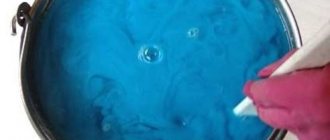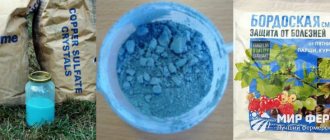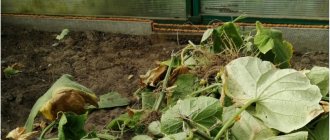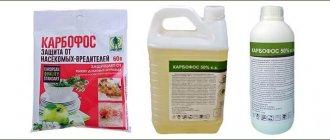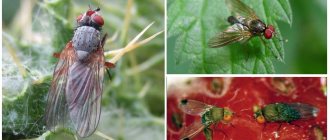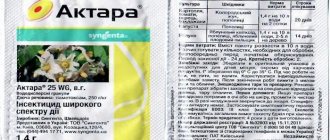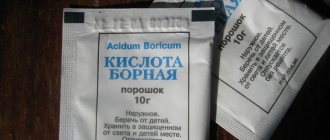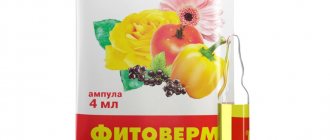General characteristics of copper sulfate
In a chemical sense, copper sulfate is a salt of sulfuric acid - sulfate. In agriculture, it is used as a fungicide, antiseptic and copper-sulfur fertilizer.
Externally, copper sulfate is difficult to confuse with something else. It appears as a bright blue powder and dissolves easily to form an equally blue aqueous solution. Copper sulfate is valued by plant growers for the following advantages:
- availability and low price;
- variability of application;
- work with a wide range of pathogens;
- when used correctly, microorganisms are not addictive;
- low level of danger for humans and bees.
It also has disadvantages. If the rules of use are not followed, copper sulfate can exhibit phytotoxicity, which manifests itself in the form of premature leaf fall in tree crops and the appearance of a dry “net” on the fruits.
Another serious drawback is the high acidity of the substance. When copper sulfate enters the soil, it causes a significant shift in pH to the acidic side. Therefore, copper sulfate is most often used in combination with lime, which neutralizes acidity. However, this option is not without its drawbacks. Excess copper in the soil leads to the death of beneficial soil bacteria and deterioration in the absorption of iron, leading to chlorosis.
Important! To reduce the harmful effects of copper sulfate on the soil, it is better to apply it by spraying plants, reducing watering to the required minimum. In this case, treatment of plants with copper sulfate should be supplemented with intensive soil treatments with EM preparations.
Features of copper sulfate
Before you start working with copper sulfate, familiarize yourself with some of the features of the drug:
- A heaped teaspoon contains 6 grams of the drug.
- Despite the fact that copper sulfate belongs to the 3rd hazard class, protection of the skin, eyes and respiratory organs is a necessity.
- It is not permissible to treat apple trees at temperatures exceeding air temperatures of +30 degrees. There is a risk of burning the leaves of the plant and the bark of a young, immature plant.
- Spraying with copper sulfate is not allowed if there is an apiary of bees nearby, since the drug is harmful to these insects.
- Treating trees with copper sulfate in the spring near water bodies and containers with drinking water is strictly prohibited.
- A solution correctly added to the lime will help to carry out enhanced treatment of tree trunks.
Fungicidal and insecticidal properties of copper sulfate
The price of copper sulfate depends on the manufacturer and fluctuates around 30 rubles per 100 g of the drug.
Most often, copper sulfate is used to combat fungal diseases of plants. Its toxic effect on pathogens develops according to the following scheme:
- copper ions bind to enzyme complexes of fungal cells;
- the cell cytoplasm coagulates and denaturation of proteins occurs;
- The Krebs cycle, which ensures cell respiration, is interrupted.
A similar process occurs when copper sulfate interacts with insect cells. But in this case, the drug acts more selectively, showing high toxicity towards eggs and larvae of pests.
Copper sulfate - what is this substance?
Copper sulfate is an active hygroscopic powder in the form of blue-blue crystals. It contains 980 g/kg copper sulfate. In an aqueous solution, it can protect trees, berries, grapes, vegetables and flowers from diseases for 30 days. After spraying, copper ions come into contact with a bacterial or fungal cell and inhibit lipoprotein and enzyme complexes in it. In this case, the protoplasm changes irreversibly and nonspecific denaturation of proteins occurs.
In other words, copper sulfate for plants is 5-hydrate 2-valent copper sulfate - CuSO4x5H2O. This product should not be handled carelessly.
Important to remember! Copper sulfate powder is classified as a class 3 hazardous chemical. It has a toxic effect when it comes into contact with a person’s mucous membranes or inside. The lethal dose of a 5% solution is 30-50 ml. If you do not take precautions when working with copper-containing liquid, it can penetrate the skin through the glands when sweat is reabsorbed.
Proper use of the chemical does not lead to long-term unwanted and side effects, since it does not have a cumulative effect, but only biocidal and fungicidal . The substance is not resistant to harmful objects, that is, it is not addictive and does not increase their resistance, so the powder is often used to combat mold. In addition, Cu (II) ions are a copper-containing microfertilizer, which promotes the synthesis of phytohormones in plants.
Pathogens sensitive to copper-containing fungicides
Copper sulfate and mixtures based on it cope well with the following plant diseases:
- peronosporosis;
- coccomycosis;
- moniliosis;
- late blight;
- cercospora;
- scab;
- different types of spots;
- rust;
- septoria;
- anthracnose;
- ascochyta;
- powdery mildew.
At the same time, copper sulfate has a poisonous effect on psyllids, aphids, caterpillars and many other insects. A number of publications also mention the effectiveness of copper sulfate against spider mites.
Copper sulfate is suitable for spraying pome and stone fruit crops, currants, gooseberries, grapes, tomatoes, cucumbers, beets, potatoes, onions, raspberries.
Advantages and Disadvantages Compared to Other Mold Remedies
Copper sulfate has been used as an antifungal agent for decades . Its extraordinary popularity is explained by the following positive qualities:
- high efficiency;
- very affordable price;
- various packaging (packages from 50 g to 25 kg);
- long-term protection against the recurrence of fungus;
- ease of use and practicality.
Among the disadvantages of this substance compared to other anti-mold agents, one can note its inability to cope with old pockets of mold that have become deeply embedded in the walls. If the infection is widespread, you should not rely heavily on the effectiveness of copper sulfate; it is better to immediately select more potent drugs.
Fungicidal mixtures based on copper sulfate
For the preparation of medicinal preparations, copper sulfate is suitable both on its own and as part of mixtures. Complementary components partially neutralize the negative effect of copper sulfate on plants and enhance its fungicidal properties.
The most widely used mixtures based on copper sulfate are:
| Mixture | Preparation | Characteristic |
| Bordeaux (1%) | Separate aqueous solutions are prepared from 100 g of copper sulfate and 75 g of slaked lime. Each component is diluted in 5 liters of water. Then the solutions are combined. | The acidity of copper sulfate is neutralized. At the same time, calcium ions are involved in working with pathogens. |
| Burgundy (1%) | Separate solutions are prepared from 100 g of copper sulfate and 50 g of soda ash. Each component is diluted in 5 liters of water. Then the solutions are mixed. | Soda ash also neutralizes copper sulfate. The properties of the mixture are similar to Bordeaux mixture, but it adheres worse to the leaves. To make it stick, you can add soap to it. |
As an independent preparation, copper sulfate can be prepared in different concentrations:
- to obtain a 1% solution, take 100 g of the substance per 10 liters of water;
- to obtain a 0.5% solution, take 50 g of the substance for the same amount of water.
A weaker concentration is used for pre-sowing disinfection of bulbs and tubers. To do this, the material is generously sprayed with the preparation immediately before planting.
To protect vegetative plants, a stronger 1% solution of copper sulfate is used.
Tip #1 . Copper sulfate can be used to treat seeds before sowing. To do this, make a very weak solution of 1 gram of the substance and 1 liter of water. The resulting preparation is either generously sprayed onto the seeds, spreading them on a napkin, or immersed in the solution for 1-2 minutes.
When is the treatment carried out?
Work in spring
Treatment of plants with copper sulfate in the spring is carried out for therapeutic and prophylactic purposes when:
- The air temperature will be stable - above 5°C, and will not decrease. Treat the soil with a 0.5% solution - 3.5-4 l/m² to prevent fusarium (yellowness) of root crops, white and gray rot in tomatoes, black rot in cabbage.
- Before the buds of fruit plants open, to prevent the above-mentioned diseases of black cancer and fruit rot.
- Treat with a 1% solution.
- Before planting the seedlings, the root system is dipped in a 1% mixture for 3 minutes, then washed abundantly with water. If there is no running water or if there is insufficient water in the containers, the roots are intensively rinsed for 3-5 minutes in 3 containers with water in turn.
- Before planting potatoes, tubers are dipped or sprayed in a 0.2% solution to prevent late blight.
- Before planting cucumbers, soak the seeds in a warm mixture - 0.2% for 8-10 hours, other seeds - for 20-24 hours for early germination of seedlings.
- Before planting tomatoes and pumpkin plants, in order to exclude “hereditary” diseases, prepare a mixture in 10 liters of water, adding: copper sulfate - 1 g, boric acid - 2 g, potassium permanganate - 10 g. Soak the seeds in a lukewarm solution for 15 minutes, then rinse with running water. If there is no running water, then pour new water into the container with the seeds 5 times and mix them well.
Summer work
Fruit trees and shrubs are sprayed with a 0.5-1% mixture for symptoms of the above diseases. Wounds on trunks are treated with a 1% mixture in trees, and 0.5% in shrubs. Tomatoes and potatoes are processed in case of copper starvation and signs of late blight. Prepare a 0.2% solution and consume 2-3 l/m². After 15-30 days, the treatment is repeated.
Important. During the flowering phase, copper sulfate is not used for spraying.
Autumn work
For preventive purposes in the fall, after leaf fall, plants are treated with copper sulfate (1%). In this case, free sulfuric acid gets onto the copper sulfate plant, but there will be no chemical burns in the absence of leaves, flowers and fruits. In addition, there is no penetration of copper sulfate into plant tissue. Only fungal sporangia are affected without the drug entering their mycelium. By the beginning of the new growing season after autumn treatment, the plants will receive copper and will be protected from diseases. For symptoms of powdery mildew and black spot on plants and flowers, they are treated with a 0.5% mixture.
Important. In any season, plants are treated with copper preparations in the morning or evening in calm weather and in the absence of rain. The air temperature should be 5-30°C.
Trees can be protected from pests and fungus by whitewashing the trunks with a mixture of lime and copper sulfate or methyl blue.
Copper sulfate for trees and shrubs
The period of use of copper sulfate in the garden is practically unlimited. You can work with this drug from spring to late autumn. It all depends on the purpose of processing:
| Purpose of processing | Processing method | Processing time |
| Fighting bacterial infections of fruit crops (bacterial canker, fire blight). | Spraying | Early spring, before the buds awaken. |
| Fighting fungal infections (moniliosis, coccomycosis, scab, rust, anthracnose, etc.). | Spraying | For prevention, if the plants were sick in the previous season - in early spring, before the leaves unfold. For treatment - during the summer, at the first symptoms of the disease, 2-3 times with an interval of 7-10 days. To destroy overwintering pathogen spores - in the fall, after leaf fall. |
| Pre-planting disinfection of seedlings. | Immerse the root system in a 1% solution for 3-5 minutes, followed by rinsing with water. | In spring or autumn before planting. |
Copper sulfate is often used after pruning fruit crops. This drug is good
A pure solution of copper sulfate does not adhere well to leaves, so gardeners often add laundry soap to it. This must be done carefully to prevent the formation of sediment.
protects cuts and cuts from infection. A 1% solution is suitable for processing, which can be applied to sections with a clean brush or spray.
To treat trees after pruning, you can use a ready-made product based on copper sulfate - “RanNet” garden paste.
How to use solutions in the garden and indoors
Instructions for using copper sulfate in the garden:
- Disinfect open ground or soil in a greenhouse 8-10 days before planting seedlings or seeds with a 3% solution: 30 g of powder per 1 liter of water. This remedy can protect potatoes from late blight.
- The fleshy root system of tuberous plants or bulbs is placed in a 1% mixture for 3 minutes, then washed and air dried.
- Indoor plants are protected from diseases with a sky-blue solution: take 1 tsp per 2 liters of water. powder without a slide. The mixture is poured under the root or sprayed on the leaves.
- Apple trees, pears, quince. Treatment of pome trees with copper sulfate is carried out for phyllosticosis and other spotting, scab, moniliosis, and drying out. For 10 liters of liquid – 100 g of the drug. The trees are treated for the first time before the buds open and 2-5 liters of the mixture are used for 1 tree. Repeat the treatment half a month before harvesting.
Copper sulfate for stone fruit trees is diluted for treatment of clasterosporosis, coccomycosis and other spots, moniliosis, leaf curl with a solution: water - 10 l, powder - 50-75 g. Sprayed for the first time in early spring before buds open and spend on the tree - 2-3 l mixture.
All types of currants and gooseberries are sprayed for the first time in early spring before the buds open and 1.5 liters of the mixture are used per bush: water 10 liters, powder – 50-75 g.
Vegetable processing:
- Before planting, potato tubers are placed in a net and dipped against late blight in the following solution: 2 g of powder per 10 liters of water.
- Vegetables are sprayed when spotting appears, for example, on cucumbers (ascochyta blight) with a 0.5% solution of urea (10 g) and vitriol (5 g) in water - 10 liters. Spray 2 times with an interval of 7-8 days.
- Melon plants: pumpkins, zucchini, melons, watermelons, cucumbers are sprayed 5 days before harvest.
In order to prevent root rot in melon plants, which can be seen by wilting of the bushes on hot days, yellowing of the leaves, dying off of the ovaries, and stopping the growth of seedlings, you need to treat the bushes with the following solution: add 1 tsp per 10 liters of water. copper sulfate, zinc sulfate and 1 tbsp. l. superphosphate. Use a freshly prepared solution at the rate of 5 l/m² of soil. Save vegetables and flowers from blackleg and fusarium with a solution: water - 10 l, preparation - 5 g.
About tomatoes
Tomatoes suffer from late blight, but their leaves are sensitive to copper. To avoid burns, you need a 0.2% solution of copper-soap emulsion: mix grated laundry soap - 200 g with hot water, separately dilute copper sulfate - 20 g in a glass jar and stir with a wooden spoon. Pour this fungicide into the soap solution in a stream and add up to 10 liters of water.
Treatment scheme: seedlings are processed first, then seedlings 7-8 days after planting in a greenhouse or open ground. During the dry season, tomatoes are not sprayed with a copper-containing mixture, but treated with Fitosporin. After a cold spell in August, treat with the above mixture. During damp and cool summers, the mixture is treated every 10-12 days in calm weather without wind. At the same time, try to wet the tomato leaves from the reverse side. If there are symptoms of late blight, then a week before harvesting the tomatoes, the plant can be sprayed and then washed well before eating.
It is important to know. Raspberries, strawberries, ripe apricots, peaches that have soft and cracked skins, grapes, and soft currants are sprayed 45 days before harvest, since these crops cannot be rinsed well with water before use. They are processed once before the flowering phase, and once after the ovary.
Copper sulfate for processing vegetable crops
Vegetable crops are treated with copper sulfate and its mixtures throughout the entire growing season. Preventive spraying can be carried out starting in May:
| Culture | Disease | Method of use of the drug |
| Tomatoes, peppers, eggplants | Blackleg | Watering the planting holes 1 day before planting seedlings in the ground. |
| Late blight, blight, verticillium blight, fusarium blight, gray rot, alternaria blight, anthracnose. | Spraying | |
| Bacterial wilt, root canker | Water at the root, only when symptoms of the disease appear, as part of a Bordeaux mixture. | |
| Cucumbers, zucchini | Blackleg | Watering the planting holes 1 day before sowing or planting seedlings. |
| Powdery mildew, downy mildew, spotting, black mold, fruit rot, anthracnose, rhizoctonia | Spraying | |
| Root rot | Water at the root, when symptoms appear, as part of a Bordeaux mixture. | |
| Onion | Downy mildew | Pre-sowing spraying of bulbs - for prevention. Spraying on the feathers - for treatment. |
| Beet | Cercospora blight, downy mildew, fomoz | Pre-sowing spraying of bulbs - for prevention. Spraying on leaves - for treatment. Watering - only as part of the Bordeaux mixture. |
As a rule, 1-2 procedures with an interval of 10 days are sufficient for prevention. If the plants still begin to get sick, a solution of copper sulfate is applied until the infection is completely eradicated at intervals of 7 days.
Efficiency of use in gardening and horticulture
Keeping copper sulfate on hand during the summer season is a must. In recent years, powdery or downy mildew has been found in vegetable gardens and orchards 3 times more often than 10 years ago.
Copper sulfate will provide quick treatment, get rid of harmful fungus, and save the plant. Spraying will help with infection of grapes, ornamental and vegetable crops. As well as all fruit trees and shrubs.
For convenience, it is advisable to purchase a spray bottle. The device provides easy application to the surface of the “garden dweller”. The summer resident speeds up the processing process.
A special feature of use is double application. After the first time, wait 21 days and apply a new spray. The interval is observed even after rains. When the water drains, the vitriol solution gets into the ground. This means that the roots absorb the fertilizer. The protective function is strengthened, and pests are destroyed.
Technology
A one percent solution of copper sulfate is called a working option. Suitable for spraying wood, soil, green parts (in summer when diseases appear). Standard use involves dissolving at least 10 g in a liter of warm water.
If it is necessary to carry out preventive measures with seedlings, a 1% mixture will also be required. Making copper sulfate at home for the required effect is quite easy.
Just make sure the calculation is correct. In the agricultural industry, solutions are purchased ready-made and used in larger quantities. The calculation is made by a specialist.
If you don’t know how copper sulfate is diluted for spraying, you can overdo it with the dosage. Which will harm the plant. To avoid mistakes, there is always a chance to use analogues of the substance.
Such mixtures also include a 1% solution of copper sulfate. Spraying products are already sold in liquid form, which simplifies use.
For more serious measures: eliminating diseases, preparing the garden for winter, take 2%, 3%, 5% solutions. Prepare 3% copper sulfate or how to prepare a 5% mixture at home is indicated on the package.
Application of copper sulfate in the vineyard
Copper sulfate is actively used by winegrowers to protect vines from a number of infectious diseases:
| Disease | Method of using copper sulfate |
| Oidium, dry sleeve | Coat the shoots with a brush dipped in a 3% solution of copper sulfate (300 g per 10 liters of water). Processing time: autumn, after leaf fall and pruning. |
| Mildew, anthracnose, spotting. | Spray before leaf unfurling or when symptoms appear. |
Instructions for use
Each sachet of copper sulfate powder comes with accompanying instructions for use, which are recommended to be carefully studied beforehand.
How to dilute copper sulfate
To combat mold, a vitriol solution is used, which should be prepared in a separate glass, ceramic or plastic container not intended for cooking and eating. The standard concentration involves diluting the working solution in a ratio of 1:100 (1%), that is, 100 g of granules per 10 liters of water. But in case of severe fungal infection, the solution can be made stronger - 3:100 (3%) - 300 g of substance per bucket of water.
It is better to dilute copper sulfate in glass containers
First, the required amount of copper sulfate is dissolved in a small amount of heated water (+40...+50 °C), stirring vigorously with a wooden spatula or stick. Then it is cooled and filtered to remove undissolved crystals, and only then the volume is adjusted to the required volume. To enhance the disinfecting and disinfecting effect, add any liquid chlorine-containing agent or table vinegar to the composition at the rate of one tablespoon per liter of working fluid.
To make it easier to see the already treated areas of the walls, you can add aniline dye to the solution (½ g per 10 l).
How to apply the solution to walls to eliminate and prevent fungus
Since copper sulfate effectively affects only fungal spores, but is ineffective against mycelium, the surface to be treated must first be prepared, and only then the fungicide must be applied. The technology is like this:
- All fungal plaque is removed mechanically. The decorative coating is removed, the wallpaper is mercilessly torn off, paint, putty or plaster is scraped off with a metal spatula or scraper.. Severely ingrained mold is cleaned with sandpaper.
The walls must first be cleaned of mold. - Then the affected areas are thoroughly washed with a soap solution (40 g of ordinary laundry soap per 1 liter of water) and left until completely dry.
- After this, proceed directly to applying the vitriol solution. To do this, you can use a wide brush, roller, sponge or spray.
- Allow the surface to dry (on average 4–5 hours, but sometimes up to 12).
- Re-treat all areas affected by the fungus.
The walls are treated with copper sulfate solution several times - Depending on the degree of penetration, the procedure is repeated up to 6 times, not forgetting to dry each applied layer.
- After about two days, you can begin finishing work and applying a decorative layer (painting, wallpapering, plastering, etc.).
It must be remembered that without removing the very cause of mold (dampness, poor ventilation, etc.), it will not be possible to get rid of it completely. Some time after treatment, the fungus will inevitably become active again.
Copper sulfate as a plant food
Copper sulfate turns out to be very useful for the prevention and treatment of all types of rots that affect berries - botrytis, black rot, aspergillosis, etc.
Copper sulfate often helps to eliminate copper and sulfur deficiency in plants. For feeding, a solution of low concentration is prepared:
- 2 grams of the substance are diluted in a 10-liter bucket of water;
- Plants are sprayed leaf by leaf when symptoms of copper or sulfur starvation appear.
With a lack of copper, growth is inhibited, necrosis of the apical meristems develops, and young leaves become twisted and twisted.
Sulfur deficiency is visually determined by shredding of leaves with simultaneous elongation of stems and shoots, coarsening of petioles and leaf blades. The leaves themselves turn pale, but do not turn yellow or die, as with nitrogen deficiency.
It is enough to fertilize with copper sulfate in 1-2 doses with an interval of 15 days.
Procedure for processing plants and trees
Spraying fruit trees with copper sulfate should proceed according to the following scheme:
- preparation of raw materials for processing. You can use it after the granules have completely dissolved;
- leave to infuse for 2 hours. Then pour into the sprayer;
- will adjust the jet. Direct from top to bottom;
- Make sure that there is no dry space left on the trunk, branches, or leaves.
On the ground, treating the soil with copper sulfate in the fall is easier. You should start from the far corner of the garden, slowly watering the soil. Allow to dry.
Important! Any manipulations with copper sulfate solution are carried out in calm weather. During the flowering period, the fungicidal liquid kills not only parasites, but also the plant itself. When spraying at this time, it does not matter whether there is wind or not. The flowers will fall off anyway. There is no need to wait for the harvest.
Analogues of copper sulfate: description and properties
The modern agrochemical industry actively uses the properties of copper sulfate, creating drugs with a deeper and wider spectrum of action:
| A drug | Description | average price |
| "Oxyhom" | Contains copper oxychloride in combination with oxadixyl. Unlike copper sulfate, it acts not only on the surface of the leaves, but also in the deep layers of plant tissue. Find out → how to use Oxychom against late blight. | 50 rubles for 10 g |
| "Abiga Peak" | An analogue of copper sulfate, containing copper in the form of oxychloride. Like copper sulfate, it acts only on the surface, but has neutral acidity and adheres well to the leaves without additional adhesives. Find out → how to use Abiga-Pik for diseases. | 55 rubles for 50 ml |
| "Kuproksat" | It consists of copper sulfate in the form of a suspension concentrate. Completely replicates the effect of powdered copper sulfate, but is more convenient to dilute. | 60 rubles for 50 ml |
| "HOM" | Contains copper oxychloride. Effective for prevention and in the initial stages of diseases. It has neutral acidity and combines better with other pesticides than copper sulfate. Find out → how to use copper oxychloride for diseases, reviews. | 30 rubles for 20 g |
As can be seen from the table, modern analogues of copper sulfate are superior to their “big brother” in a number of ways. It is no less effective and safer for plants than copper sulfate. However, their price is significantly higher.
What is copper sulfate used for and how to use it in gardening
Any summer resident wants to grow and harvest strong, healthy vegetables, fruits and vegetables, but the conditions in the garden beds are far from ideal.
Copper sulfate, the use of which in gardening has long proven its effectiveness, is one of the most well-known fungicides that counteract pathogenic fungi. The experience of using copper sulfate in gardening and horticulture is more than a century old. During this time, other chemically active compounds appeared, but copper sulfate is still in demand today. Thanks to copper, this compound not only protects plants from dangerous diseases, but also has a beneficial effect on the quality of the crop.
Reviews about the use of copper sulfate
New generation copper-containing fungicides effectively treat fungal infections, but cannot be used to feed plants, which makes them inferior to copper sulfate.
If you talk to experienced gardeners of the “old school”, you will find that many of them remain faithful to copper sulfate, proven for decades, despite the large assortment of modern analogues:
“I have a large garden, 20 acres, and two greenhouses, and I very rarely buy anything for diseases other than copper sulfate. If agricultural technology is correct, then the plants almost do not get sick. And when any misfortune happens, the main thing is to grasp its very beginning and act quickly. Then copper sulfate normally deals with the infection, and nothing more is needed. Personally, for my garden, one spring treatment with a mixture of vitriol and urea is enough to get a harvest and not suffer from diseases” (Vladimir Kharitonovich, Stavropol Territory).
Other experts also speak about the benefits of a mixture of copper sulfate and urea:
“In my experimental plot, we sprayed adult cherries with a solution of copper sulfate and urea (100 g of copper sulfate and 700 g of urea per 10 liters of water). The treatment was carried out at the very beginning of sap flow, in the green cone phase. The result was positive. Compared to the control group, the cherries were better able to resist seasonal damage by clasterosporia and did not suffer from gray rot. In addition, they began to bloom a week later, which allowed the flowers to avoid returning frosts. As a result, the yield from these samples was 37% higher than from the control ones.”
A. Vasilyeva, agronomist
Application depending on plant type and diseases
Preparation of the working solution, rates and timing of application of the substance depend on the purpose of its application.
Processing of fruit and berry plants
The use of copper sulfate in gardening is justified when fruit trees and shrubs are infected with various pests, scab, rust, chlorosis, and other common diseases. Treatment of cultivated plants is carried out with a 1% or 3% solution of the drug (100 or 300 g of vitriol must be diluted with 10 liters of water). The consumption of the working solution is (l per bush/tree):
- for young plants (up to 3 years) – 2;
- during the period of active growth (3-4 years) – 3;
- for mature plants (5-6 years) – 4;
- for fruit-bearing crops – 6.
Since the components of the drug easily penetrate the soft tissues of the fruit, treatment of the garden with copper sulfate should be carried out no later than 1.5 months before harvesting.
Collected fruits must be washed before eating to remove the film formed by harmful substances from the preparation.
Bordeaux mixture
Preparation of Bordeaux mixture
The acidity of copper sulfate is its serious drawback. It can be reduced by adding 0.2-0.5 liters of hot water to the working solution, in which 3-5 g (before foaming) of laundry soap is dissolved. This additive will also improve the adhesion of the solution to the leaves.
But Bordeaux mixture is much more effective - a combined solution of copper sulfate and slaked lime. It is known in 2 varieties: strong 3% (300 g of copper sulfate and 400 g of lime per 10 liters of water) and gentle 1% (100 g of both for the same volume). Strong Bordeaux mixture is used for autumn and possibly early spring treatment, and gentle liquid is used during the growing season. The only bad thing about Bordeaux mixture is that it is completely incompatible with any other drugs or soap. And its substitute with soda ash - Burgundy liquid - is much less effective.
Note: it is recommended to use Bordeaux mixture for processing grapes only in the fall. In other cases, it is advisable to use formulations based on iron sulfate for this crop.
To prepare Bordeaux mixture, you need to pour the required volume of water in half into 2 containers. Lime milk is dissolved in one; into another copper sulfate. The blue solution is gradually poured into the white one, stirring, see fig. on right. The finished solution is allowed to stand for 3-4 hours, filtered and poured into a sprayer. The shelf life of freshly prepared solution is one day.
Note: Prepackaged mixtures for preparing Bordeaux mixture are available for sale. How to prepare a working solution from the finished mixture, see next. video:
